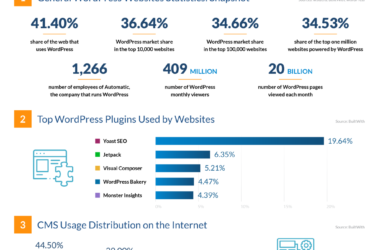Google’s search algorithm is getting more intelligent in terms of keyword relevance and content, and it searches for relevant topics. With so many pieces to optimize – from keyword searches to ideas for technical SEO content – it’s easy to get confused or overwhelmed about increasing your visibility in search. There are billions of websites online, which means that search engine algorithms have to sort vast amounts of data to organize web content and provide users with the content most users like. The ultimate goal of any SEO strategy is to index and elevate your website in search engine rankings and provide helpful information to your target audience. On-page SEO is one of the SEO strategies of which you have complete control.
Let’s dive into what on-page SEO is and how you can maximize your efforts to get the best results.
What is On-page SEO?
On-page SEO (also known as On-Site SEO) is optimizing websites to compete with search engines better. Google looks at your content on the page to see if it is relevant to search results. On-Page SEO can help you better position your site in the eyes of search engines and direct more relevant traffic to your website.
On-Page SEO includes all the actions you can take on your website to improve the authority of your websites and their ranking in search engine results. It helps to optimize the structure of website content for search engines and users alike. With high-quality on-page optimization, you can help search engines link your content to the relevance of a particular query or keyword users are looking for.
Tips for On-page SEO
How your site appears in search engine search results pages (SERPs) is determined by several ranking factors, including website accessibility, page speed and optimized content, keywords, and title tags. If you want to rank higher, you should optimize your content with the guidelines of On-Page SEO. It includes optimizing title tags, content, internal links, and URLs. On the other hand, off-page SEO refers to backlinks and social sharing that signal to search engines that your site is rank-worthy. Here are some actionable tips to follow for on-page SEO.
Create great content with relevant keywords and related topics
Content is the reason people visit your blog site. The best approach for increasing ranking is to create original, unique, high-quality, and informative content that will benefit your audience. Google attaches great importance and priority to a page that answers a search query to determine the ranking. You need to create content that answers the users’ questions and ensures that search engines know what your content is about and why it merits ranking. According to Pui Teng from Sell Click, you can use SEO tools like SurferSEO to suggest the density of important terms, word count, images, and headings needed for your content to rank for your target keyword.
The page content is your chance to add value to your website’s visitors, so they are at the heart of the site’s SEO process. Ideally, your content should match the search intent of the person who is viewing your web page. If it doesn’t, your bounce rates will increase.
All other SEO elements come from high-quality page content, and people invest plenty of resources in developing and optimizing content. Before you start writing your content, you should do an analysis of the top three pages that are already ranking on Google and make a note of the length of the articles, and the number of images and videos they have.
The initial step to creating high-quality content is selecting relevant keywords. Make sure that you do keyword research well and write content for low competition, long-tail keywords. Prepare a list of your primary and secondary keywords and include them in your content. You need to enrich your content with Latent Semantic Indexing (LSI) keywords to make it relevant to broader topics. These keywords are semantically linked to a keyword and reference conceptually related terms that search engines use to understand content on a page. Once you have chosen the target keywords, you can create a list of related keywords and use them in your titles, descriptions, headings, and content on the page.
Google searches for relevant search results for each query, and its algorithm searches for other relevant content on the page. For a particular keyword, make sure you include content related to other relevant content besides your keyword. You can find what additional content is relevant from Google’s search results in the Related searches section.
Use your focus keyword in the main heading and subheadings
Make sure your focus keyword is in your title. Even better, try and add it at the beginning of your title. Of course, you shouldn’t try and add it unnaturally and make your title look awkward, but if you’re able to think of a way to write an excellent title with your keyword upfront, it’s ideal for rankings. Also, make sure you use a modifier such as “best,” “review,” etc.
Use your focus keyword at the beginning and within your content
The focus keyword or the main keyword should be at the beginning of the article because if you’re writing about a topic, it is only natural that you mention the subject initially. This signals to the search engine that your content is relevant to the keyword. When you are using the keyword within your content, make sure that it makes sense in the context of your content. No one wants to read an article that has the keyword mentioned hundreds of times. It makes for a poor user experience. Search engines are smart enough to detect keyword stuffing, so using the keyword according to suggestions by SEO plugins such as RankMath or Yoast would be sufficient.
Use short, descriptive URLs with the focus keyword
Make sure that your URLs are short, and also make sure to include your keyword in the URL as well. The URL should be descriptive and should convey what the article is about.
Create a keyword-rich meta description
By default, each post or article will pick up the specified number of words from the article as a meta description. Adding a meta tag for the description to your page is a good approach if Google cannot find a good selection of text that can be used as snippets. Instead of using the default meta description, put in some time to write a keyword-rich meta description to have your post rank in the search results. Don’t forget to include your main keyword in the meta description. Ensure that your meta description is concise, engaging, and contains your keywords, and matches users’ search intent.
Remove duplicate content
Duplicate content is terrible for SEO on the site, so check your site for duplicate content and remove it. Duplicate content throws a wrench into your content funnel and makes a poor user experience.
Optimize images
Search engines similarly search images and inserting relevant keywords describing the image will help them understand the content of your pages. Make sure that your images are named appropriately and have descriptive alt text. It would help if you had keyword-rich alt text, but don’t overdo it. Give a concise description of the image to result in a good user experience when screen readers read it. Also, make sure to compress images so that they load faster. This is one of the ranking factors for your website.
Use Internal linking
Internal links are valuable for SEO. Wherever you can, make sure to include relevant links. If you have high-authority pages, linking to pages that have low authority can help them rank. Make sure that the links are relevant and add value to the content.
Pro tip: manual internal linking gets boring real quick, so use a plugin like Link Whisper to automate it and still reap the SEO benefits of internal links.
Tools for On-page SEO
On-page SEO leads to higher search results, increased traffic to your site, more conversions, better customer experience and customer loyalty. With on-page optimization, you can make your website more usable and helpful to users and improve your rankings in search engines, increasing organic traffic, longer dwell times, and reduced bounce rates. Several plugins can help you with basic on-page SEO optimization. RankMath and Yoast are some of the best-known ones. For advanced SEO optimization, several AI-powered tools such as Surfer SEO, Clearscope, Dashboard, etc., can compare how you rank against competitor pages and suggest how you can improve your content score. There are several on-page SEO and SERP tracking tools that can help with research, writing, and optimization. For example, Conversion.ai is one such tool that has partnered with Surfer-SEO to provide both content writing and optimization features.
Off-page SEO
Once you have great content on the site that includes informative and transactional keywords that tell a story that appeals to your audience, it is time to focus on off-page SEO, or creating links in the right way to improve search engine rankings. If a keyword is very competitive and you are just starting, you will not rank on the first page of search engines, no matter how well you optimize your page. You also need off-page SEO optimization to increase the value of your page in the eyes of search engines.
Final Thoughts
With both on-page and off-page SEO strategies, you can improve your search engine rankings, increasing traffic and conversion on your website. Although it takes time, once your SEO strategy gets underway, your online ranking will improve. With the proper on-page SEO tools and techniques, you can improve your ability to meet Google’s criteria and improve your positioning in SERPs. SEO and Google algorithms will change regularly, so you should optimize your pages to make sure you do it right.










